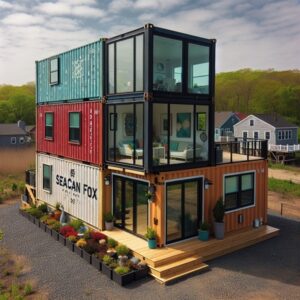
Key Takeaways
- Off-grid container homes in Colorado offer independence from public utilities and a sustainable way of living.
- Solar panels, wind turbines, and battery storage are common power solutions for off-grid homes.
- Rainwater catchment systems and greywater recycling are essential for water management in off-grid living.
- While the initial investment for off-grid systems can be high, long-term savings on utilities are significant.
- Colorado’s regulatory environment is becoming more favorable for off-grid living, but it’s important to navigate the rules carefully.
Introduction to Off-Grid Container Homes in Colorado
Going off-grid means you’ll need to think about two main utilities: water and power. How will you generate electricity? How will you source water? And importantly, how will these choices impact your wallet? We’ll explore these questions in detail, offering clear, actionable advice that you can use to make your off-grid dream a reality.
Advantages of Container Homes
Container homes come with a unique set of advantages that make them an attractive option for the eco-conscious homeowner. They are:
My Favorite Container Homes Resource
I compared the top 3 Container Home Guides
to discover the ultimate resource!
See my top recommendation here
- Durable: Made from steel, they are designed to withstand harsh conditions.
- Modular: Their inherent structure allows for creative designs and additions.
- Eco-Friendly: Repurposing shipping containers reduces waste and the need for new materials.
Plus, their industrial chic vibe is pretty cool, too.
Overview of Regulatory Environment
Before diving into the nitty-gritty of off-grid living, it’s crucial to understand the local laws and regulations. Colorado is known for its progressive stance on alternative living arrangements, but you’ll still need to navigate building codes, zoning laws, and permits. Don’t worry, though. For specific questions, you might have, this FAQ section will guide you through the essentials to ensure your container home is up to code and fully legal.
Designing Off-Grid Infrastructure in Colorado
Designing an off-grid container home requires careful planning, especially when it comes to infrastructure. You’ll need to consider how to generate electricity, manage water, and deal with waste in a way that’s both practical and sustainable. Let’s break it down.
Power Options for Off-Grid Living
When it comes to power, the sun is your best friend in Colorado. The state enjoys over 300 days of sunshine per year, making solar panels a popular choice for off-grid homes. Wind turbines can also supplement your energy needs, especially in the windy plains and high altitudes.
Here’s a quick rundown of your power options:
- Solar Panels: Capture the sun’s energy and convert it into electricity.
- Wind Turbines: Use Colorado’s breezy conditions to generate power.
- Battery Storage: Store excess energy for use when the sun isn’t shining or the wind isn’t blowing.
Each of these options has its own set of considerations, from installation costs to maintenance, but the payoff is a home that’s powered by nature. For more detailed insights, you might want to explore efficient heating and cooling systems for container homes.
Water Collection and Management
Water is life, especially when you’re living off-grid. Colorado’s semi-arid climate means you’ll need to be savvy about how you collect and use water. Rainwater harvesting is a great way to start, but you’ll also need to think about purification and storage.
Here are the essentials for water management:
- Rainwater Catchment: Collect rainwater for use in your home.
- Water Purification: Ensure your collected water is safe to drink and use.
- Water Storage: Store purified water for use throughout the year.
With the right system in place, you can turn Colorado’s limited rainfall into a reliable water source for your home.
Greywater System Implementation
Don’t let water go to waste! Greywater systems allow you to reuse water from sinks, showers, and washing machines for irrigation and other non-potable uses. This not only conserves water but also reduces the load on your septic system. It’s a win-win for sustainability and efficiency.
Remember, the goal here is to create a home that works with the environment, not against it. By carefully designing your off-grid infrastructure, you can achieve a level of independence and sustainability that’s truly liberating.
Comparison with On-Grid Costs
One of the most pressing questions for potential off-grid homeowners is the cost comparison with traditional on-grid living. Let’s be clear: setting up an off-grid home requires a significant upfront investment. Solar panels, wind turbines, and water systems don’t come cheap. However, these costs must be weighed against the long-term savings on utility bills, the resilience against power outages, and the priceless peace of mind that comes with self-sufficiency.
For example, a typical solar setup might cost anywhere from $10,000 to $30,000, depending on your energy needs. But once installed, your energy costs can drop to nearly zero. Over time, these systems pay for themselves and can even generate excess power you can sell back to the grid if you choose a hybrid setup.
Most importantly, remember that living off-grid in Colorado isn’t just about the numbers on a spreadsheet. It’s about a lifestyle choice that values independence, sustainability, and a closer connection to nature.
Sustainable Living and Off-Grid Container Homes in Colorado
Choosing to live off-grid in a container home is a powerful statement about your commitment to sustainability. These homes are more than just a place to live; they’re a testament to the possibilities of modern, eco-friendly design and living practices.
Eco-Friendly Practices
Building an off-grid container home is just the beginning. To truly embrace sustainable living, you should consider the following practices:
- Using energy-efficient appliances to reduce power consumption.
- Implementing composting toilets to minimize water usage and produce valuable compost for your garden.
- Landscaping with native plants to reduce the need for irrigation and maintenance – see this Xeriscaping Guide for Colorado
Each of these practices contributes to a greener, more sustainable home that works in harmony with Colorado’s environment.
Off-Grid Lifestyle Benefits
There’s something deeply satisfying about knowing you’re not reliant on the grid for your daily needs. Beyond the environmental benefits, off-grid living can bring a sense of accomplishment, self-reliance, and tranquility. You become attuned to the rhythms of nature, the changing seasons, and the resources you consume. It’s a lifestyle that can bring you closer to your family, your community, and the planet.
Challenges and Solutions
Living off-grid isn’t without its challenges. You may face technical issues with your systems, legal hurdles, or the need for lifestyle adjustments. Here are some solutions to common challenges:
- If your solar panels aren’t producing enough power, consider adding a wind turbine or upgrading your battery storage.
- For legal challenges, consult with local experts on off-grid living and stay informed about changes in regulations.
- Adjusting to a more sustainable lifestyle can take time. Start small with energy conservation and work your way up to bigger changes.
With a bit of ingenuity and determination, you can overcome these challenges and enjoy the many rewards of off-grid living.
Building Your Off-Grid Container Home in Colorado
Building an off-grid container home in Colorado is an exciting journey that can lead to a fulfilling and sustainable way of life. As you plan your project, keep in mind the importance of thorough research, quality materials, and expert advice.
Embrace the process as a chance to learn and grow. Each step, from choosing the right location to installing your water system, is an opportunity to deepen your understanding of sustainable living and your connection to the environment.
Planning Your Project
When planning your off-grid container home, consider the following steps and explore the differences between off-grid vs on-grid options to better understand water, power, and cost implications.
- Assess your energy and water needs based on your lifestyle and the size of your home.
- Research local regulations and obtain the necessary permits before starting construction.
- Work with reputable suppliers and installers to ensure your systems are reliable and efficient.
er
Colorado Container Home Summary:
| Feature | Off-Grid Container Home | On-Grid Container Home |
|---|---|---|
| Power | Solar panels (5-10 kW system), wind turbine (2-5 kW), battery storage (10-20 kWh) (Colorado Solar Energy Industries Association, National Renewable Energy Laboratory) | Grid-tied electrical connection, potential for solar/wind integration (Xcel Energy, Colorado Energy Office) |
| Water | Rainwater harvesting system (2,000-5,000 gallons), well water, greywater recycling (Colorado Water Conservation Board, Colorado State University Extension) | Municipal water connection, potential for well water (Colorado Division of Water Resources, Colorado Rural Water Association) |
| Waste Management | Composting toilet, on-site wastewater treatment system (Colorado Department of Public Health and Environment, Colorado Wastewater Utility Council) | Municipal sewer connection, potential for septic system (Colorado Department of Local Affairs, Colorado Rural Water Association) |
| Heating and Cooling | Passive solar design, wood stove, mini-split heat pump (Colorado Energy Office, Colorado State University Extension) | Grid-tied HVAC system, potential for geothermal or solar thermal (Xcel Energy, Colorado Geothermal Association) |
| Cost (average) | Initial investment: $150,000 – $300,000 Long-term savings: 50-80% on utility bills (Colorado Association of Realtors, Colorado Energy Office) | Initial investment: $100,000 – $250,000 Long-term utility costs: $100 – $300 per month (Zillow, Colorado Department of Local Affairs) |

Frequently Asked Questions (FAQ)
Embarking on the journey of building an off-grid container home comes with its set of questions. I’ve gathered the most common inquiries I receive and provided detailed answers to guide you on your path to sustainable living.
Whether it’s understanding the cost implications or the lifestyle changes, these FAQs are designed to give you a clearer picture of what to expect. Remember, knowledge is power, and the more informed you are, the smoother your transition to off-grid living will be.
So, let’s dive into these questions and shed some light on the nuances of off-grid versus on-grid container homes in Colorado.
What Are the Key Benefits of Living Off-Grid in Colorado?
The benefits of living off-grid in Colorado are manifold. Firstly, you gain energy independence, freeing yourself from the fluctuations and outages of the public utility grid. Secondly, off-grid living often leads to a deeper awareness and appreciation of natural resources, encouraging a more sustainable lifestyle.
Furthermore, Colorado’s abundant sunshine and expansive landscapes make it an ideal location for harnessing renewable energy. By choosing to live off-grid, you’re also likely to enjoy financial savings over time, as you eliminate monthly utility bills and potentially earn credits for excess energy production.
How Do Off-Grid Power Systems Compare to On-Grid in Terms of Sustainability?
Off-grid power systems, by nature, are more sustainable than traditional on-grid systems. They reduce reliance on fossil fuels and lower your carbon footprint. Solar panels and wind turbines generate clean, renewable energy, and advancements in technology are making these systems more efficient and affordable than ever before.
On the other hand, on-grid systems often rely on a mix of energy sources, including non-renewable ones. While on-grid homes can incorporate renewable energy, off-grid systems are designed to maximize sustainability from the outset.
What Are Typical Water Solutions for Colorado Off-Grid Homes?
“For off-grid homes in Colorado, water solutions must be efficient and sustainable. Rainwater harvesting systems are a popular choice, allowing homeowners to collect and store precipitation for various uses. Greywater recycling systems further maximize water efficiency by reusing water from sinks and showers for irrigation. Additionally, well water, when available, can be a reliable source, supplemented by water delivery services during dry spells.”
Each water solution has its own set of benefits and considerations. Rainwater harvesting is cost-effective and environmentally friendly, while greywater systems add an extra layer of conservation. Well water provides a steady supply, though initial drilling costs can be high.
Regardless of the method chosen, water conservation is a key component of off-grid living in Colorado, and careful planning ensures that your home remains hydrated and happy.
Can You Explain the Initial and Ongoing Costs for Off-Grid Living?
Transitioning to off-grid living requires an initial investment that includes the cost of solar panels, wind turbines, battery storage, and water systems. For example, a complete solar setup might range from $10,000 to $30,000. Rainwater catchment systems can cost between $2,000 and $10,000, and septic or composting toilets might run from $3,000 to $7,000.
However, the ongoing costs are significantly lower than on-grid living. There are no monthly utility bills, and maintenance costs for off-grid systems are typically minimal. Over time, the investment pays for itself, not to mention the environmental and lifestyle benefits that come with it.
What Challenges Might I Face with Off-Grid Living and How Can I Overcome Them?
Off-grid living can present challenges, such as adapting to less consistent energy and water sources or managing your systems’ maintenance. To overcome these challenges, education and preparation are key. Learn as much as you can about your systems, keep a close eye on energy and water usage, and have backup plans in place.
Networking with other off-grid homeowners can also provide invaluable support and advice. Remember, the off-grid community is growing, and there’s a wealth of collective knowledge to tap into. With the right mindset and resources, the challenges of off-grid living can be transformed into rewarding experiences.
In conclusion, whether you’re drawn to off-grid living for its sustainability, independence, or financial benefits, container homes in Colorado offer a unique opportunity to redefine your relationship with the environment. With careful planning and a spirit of adventure, you can create a home that aligns with your values and offers a lifestyle that is both challenging and deeply rewarding.
When considering the construction of a container home or bunker in Colorado, it’s important to weigh the off-grid vs on-grid options, particularly in terms of water and power availability, as well as the associated costs. Each choice has its own set of benefits and challenges, and the decision should be made based on your specific needs and the local environment.





